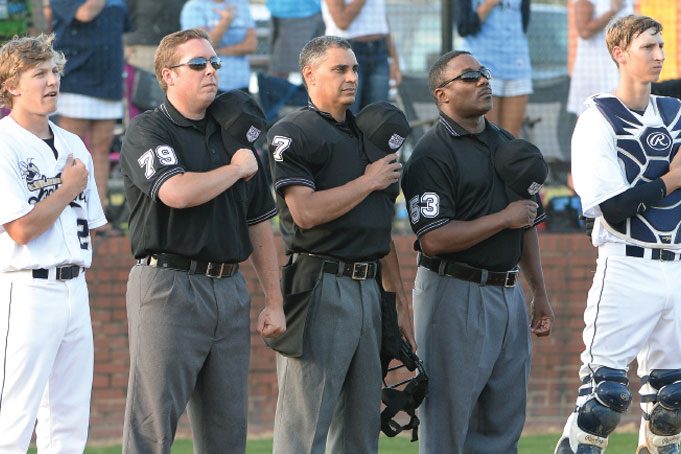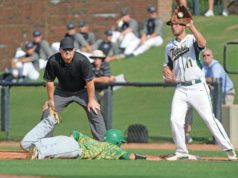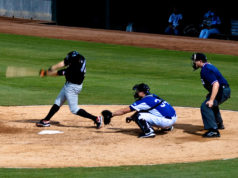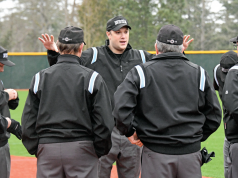As high school baseball enters the postseason, umpires face a major transition beyond the mere increased intensity of the games. In many states, the arrival of postseason play brings a shift from two umpires working a game to three or more. Umpires may even encounter that shift to a larger crew at other times of the year during special games or later rounds of weekend tournaments.
To the average observer, additional umpires on the field would seem like an instant improvement. But the shift from the two-umpire system to the three- or four-umpire system brings dramatic changes to crew dynamics. Particularly with the transition to the three-umpire system, if umpires aren’t prepared, they could end up in the wrong place, leaving a critical play with worse coverage than if a standard two-umpire crew was working the game.
Shifting from a mechanics system that is known and comfortable to a less familiar system can be challenging. Things you don’t do very often can be hard to do well — and with the extra intensity of the playoff games, umpires need to be focused on the playing action, not distracted by uncertainty with what rotation they’re potentially facing or what part of the play falls to them versus their partners.
Understand that it takes time to become comfortable with a mechanics system, and the crew is going to need to be prepared to scramble if someone forgets a rotation and moves into the wrong position. Preparation and a thorough pregame are essential.
Here are some key things to remember about the transition from the two-umpire system to the three-umpire system:
Positioning
U1 will be in the A position for the majority of the time in the three-umpire system. The only time U1 will be in the deep-B position is when there is a runner on second or runners on second and third. In that case, U3 will be in the D position rotating to deep-C and the C position depending on the situation. Some states also use a deep-B position as well but that should only happen when there is a runner at first and a right-handed batter is up. Also, some states (and some higher levels) will rotate U1 back to the A position with two outs under the reasoning that plays will likely end up at first base for the final out. Ultimately, it is important to know the mechanics your local or state association prefers umpires to use.
Box the play in
The third umpire often allows the luxury of placing one umpire in front of a runner and one umpire behind the runner.
Communication is crucial
Umpires need to communicate with one another to know where their partners are — and what they’re doing — in order to function as a unit.
When one umpire goes out
When U1 or U3 goes out, the crew reverts to the two-umpire system. Remember, U1 is the quarterback and if U1 goes out, U3 comes in and the plate umpire stays home or rotates up to third. If U1 comes in, U3 can go out if the ball is in the area or can stay and rotate down to the library area to get ready for the play at third. The plate umpire will stay at home or move up to first for a possible rundown play.
Do not go out automatically
On fly balls, use the same approach as you normally would: “Pause, read and react.” When an umpire makes the decision to go out, he or she should hustle and get a good angle and be stopped when the play occurs. The best times to go out include: when the outfielder turns and begins to run toward the outfield fence; multiple players converge on a fly ball; an attempted catch below the waist; or an outfielder moving toward the foul line and possible fair/foul decision.
Infield umpires do not go out
Just like in a two-umpire system, an umpire positioned inside the diamond does not cross the basepaths and head into the outfield on a trouble ball.
Pop-ups near the foul lines
The wing umpires can release the catch/no catch and fair/foul responsibilities to the plate umpire — especially U3, so he can come across toward second.
Overthrows
The plate umpire, except when the crew has rotated, will take responsibility for ruling on overthrows. When the crew has rotated, the responsibility shifts to U1, who is positioned at the plate.
Missed rotation
If a partner forgets a rotation, keep the rotation. Don’t miss a play because of the situation. Be vocal when you see the miscue. This allows the umpire that missed the rotation to react and get in the correct position.
Dugouts
The wing umpires are responsible for the dugout on their side of the field, such as keeping players, equipment and coaches in the dugout during live-ball action. The plate umpire can help, but he or she shouldn’t have to if the wing officials are doing their jobs.
Balks
Each umpire has different focal points for calling balks.
The plate umpire concentrates on the following: pitcher coming to a complete stop; left-handed pitchers stepping to the plate; right-handed pitchers stepping to the plate on the third-to-first move; right-handed pitchers gaining ground on the jump turn and right-handed pitchers closing their front shoulder before the jump turn.
U1 concentrates on right-handed pitchers “breaking” their front knee before the jump turn and a left-handed pitcher’s step (or body movement) to the plate; coming to a complete stop; and breaking the back edge of the pitcher’s plate.
U3 concentrates on making sure a right-handed pitcher comes to a complete stop; steps toward the plate on the third-to-first move; breaks the back edge pitcher’s plate and stepping to the plate and then throwing to a base.
Double steal
With runners on first and second and a double-steal attempt, catchers typically throw to third base, but not always. As such, U3, who is positioned in C position, will need to read the throw and shift toward the play, as shown in the MechaniGram. 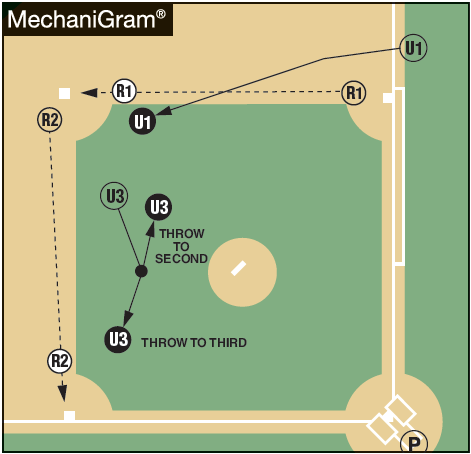 U1 has no initial responsibility on either runner, but moves toward second to assist with subsequent plays, such as a snap throw back into second.
U1 has no initial responsibility on either runner, but moves toward second to assist with subsequent plays, such as a snap throw back into second.
Review your notes or books on three-umpire mechanics a few days before the game. Good resources are the NFHS Baseball Umpires Manual and Referee’s Baseball Umpiring Mechanics Illustrated.
It’s important for the crew to meet well ahead of time to discuss mechanics. Get comfortable with the concepts and you will be ready to focus on the playing action rather than the umpire movements and positioning.
What's Your Call? Leave a Comment:
Note: This article is archival in nature. Rules, interpretations, mechanics, philosophies and other information may or may not be correct for the current year.
This article is the copyright of ©Referee Enterprises, Inc., and may not be republished in whole or in part online, in print or in any capacity without expressed written permission from Referee. The article is made available for educational use by individuals.

